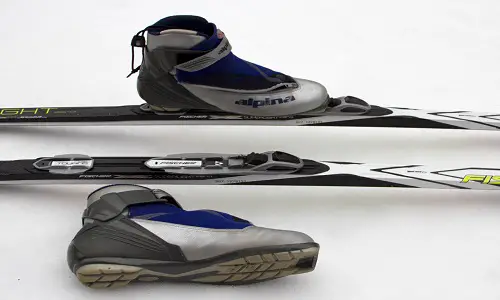Table of Contents
Cross-country skiing is meant to generate heaps of body heat, given its aerobic aspects. Whatever quality or brand you choose, it should do the basic function of protecting you adequately from cold and freezing temperatures. Concurrently, it also needs to circulate your body heat so you do not get hypothermic or chilled when your body comes to a stop. This what to wear cross country skiing guide will give you useful tips on the best clothing and multiple layers for your cross country skiing adventure.
How To Dress for Classic Cross Country Skiing?
Multiple lightweight insulating layers of clothing provide skiers with a level of warmth and versatility in low temperatures on the ski trails. Wearing layers allows to add or remove items as required, as the body may heat up or get cold fairly quickly, depending on how mobile or slow skiers are in those weather conditions. The layers are meant to trap the “dead air space” to retain heat and keep the body warm.
Base Layers of Cross Country Ski Clothing
It is natural for your body to produce a lot of sweat when you cross-country ski. This will either be due to the physical exertion and/or retaining the moisture within their clothing, given the variations in the temperature between the warm body and the cold air outside.
Base layer materials like a long underwear made out of wool or synthetic will be efficient in releasing the moisture out of your body and evaporate.
This inner base layer clothing should be tight fitting against your skin, and never be tight or restrictive. Likewise, the layers shouldn’t be too loose either, as that will lead to the circulation of moist air around or on your skin that will make you feel chilly.
Middle Layer of Cross Country Ski Clothing
The mid layer is meant to wick moisture and at the same time provides your body with the much-needed warmth.
Something like merino wool would be ideal that is thin and warm material. They are lightweight and thin fabric for a reason – you may take it off quickly during skiing, if you are feeling warm, and store it in your backpack or pocket.
If there is cold weather (or will get colder), it is always a good idea add middle layers, as opposed to wearing bulky clothing that will be hard to remove and stuff in your pack. These added layers are more efficient in taking out the moisture from your body and adjust your clothing gear to suit the weather conditions and your body temperature.
Cross Country Ski Jackets – Outer Layers
Nordic ski jackets are purpose-built as breathable fabric jackets to provide you with effective ventilation for your upper body, as required. They are made out of windproof fabrics on the entire front for wind protection when you ski against it, and stretchy and breathable material on the backside for air to pass through and regularize your body temperature.
You can check the windproof effectiveness of the fabric with the help of a ‘breath test’. Hold the jacket close to your mouth and blow hard on it. The cold wind will not pass through the jacket fabric. The front side fabric of your jacket and pants should be able to block the strongest of wind, for it to be effective. At the same time, the outer layer joints should be flexible enough to allow you to move comfortably and easily.
Unless you are skiing in rainy conditions, avoid using Gore-Tex and similar material, as these jackets aren’t breathable enough for cross country skiing. You should certainly avoid wearing fabrics made from down feathers.
XC Dress FAQs
What Cross Country Ski Pants Should I Wear?
Two base layers are generally sufficient for covering your legs. Put up a pair of light and long inner base layer that can either be cross-country pants or spandex tights. Merino wool will be ideal as it is stink-resistant.

Cross-country ski pants should be light and breathable and are usually made from stretchy soft-shell fabric to enable moisture-wicking and flexibility, as well as a well-fitted cut. Some of the variety will offer some kind of wind resistance on the front but will have more breathability on the backside.
You do not need pants for Nordic skiing, strictly speaking. Spandex or running tights will suffice too, worn under the ski boots.
Do You Wear a Helmet when Cross Country Skiing?
Unlike in alpine skiing, you do not need a helmet for Nordic skiing. You can enjoy this sport with warm hats, fit you comfortably, and matches your overall gear. For women, these hats may have a larger variety and colors to suit their fashion style, whilst men’s hats can be fairly one-dimensional. Whatever you choose, just make sure it is functional for nordic skiing purposes.

Cross-country skiing gives an effective workout and that too in no time. This means it can get hot pretty quickly and wearing a helmet will be counterproductive.
Nordic skiing involves skiing at lower speeds, one-way passages at times, and with a considerably smaller risk of bumping into something or hitting anyone else. Bearing all of that in mind, a helmet is not cross country skiing gear you should be worried about.
Why Wear a Hat for Cross Country Skiing?
Your body loses large amounts of heat through your head and hands if you do not cover it properly. On milder days, a light cap on your head that has visor will work well.
You can also wear a headband (in addition to a wool or fleece hat) to cover your ears when the temperature drops. Another effective item that can afford great head and neck protection in dipping temperatures is a balaclava.
Do not get lured into buying a spandex hat (also called condom hats due to their shape) as they may look ‘cool’ but can be tight around the head. You may want to wear something light, so you do not feel it much on your head.
What Kind of Shoes do you Wear for Cross Country Skiing? Do I Need Special Boots?
You need specialized boots that are meant to be used for cross country skiing. Although they are similar in a way, there are key differences between classic skiing boots and those used for skate skiing. So look out for that when you are shoe shopping.
The shoes should be a comfortable and good fit. Try them properly with the same pair of thin socks that you would use whilst skiing. Do not compromise on quality by opting for something that is not comfortable but cheaper. You would be better off spending decent money on a quality pair of shoes than on skis or ski poles. Shoes are that important when it comes to skiing!
Your choice of boots will ascertain the binding system you will require, that comes in two major types. Both of them are fairly similar, but your boots are made to work with either one or the other.
What Socks and Gloves to Wear Cross Country Skiing?
You will need a pair of ultra lightweight socks even if you have cold feet. Thick socks are not ideal, because the heavier the socks are (such as wool or similar fabrics), the more moisture they will hold, causing blisters on or around your feet, even during the winter months. Try to go for lengths that are above your ankle, to avoid snow getting into your feet. The more active and mobile you are out there on the trail, the warmer your toes will be. You may also consider buying boot covers for added protection for your feet, particularly on windy and cold days, or if you have a lot of standing around to do. Some skiers also prefer neoprene covers (instead of standard boot covers) that look more professional and presentable, and can be used with both – classic or skate boots.
For sunny days, when the weather is warmer, a pair of running gloves may be enough. However, if you have cold hands or it’s a cold day, thicker gloves that provide more warmth may be necessary.
Conclusion
Since cross country skiing is an aerobic activity, it generally doesn’t require too many clothes to keep you warm. A lot of heat is meant to be produced by your body as well. The trick is to wear limited items in layering that are of appropriate quality and fabric. This will help you maintain your body heat and temperature as you increase your activity levels or even when you slow down.
Having said that, cross-country skiing is undoubtedly one of the toughest endurance sports. It is one of the few sports that test your clothing if you aim to perform at an optimum level.
Whilst the expectation from the garments and the outer layer is to protect you from cold winds and freezing temperatures, they should also be breathable materials and perform the dual function of circulating excess heat from your body, so you stay ventilated.
It is normal to feel cold when you get out of the comfortable indoors and get a feeling that you are not appropriately dressed. As you get moving, your gear should start performing too. It is no different than how a runner would dress when he goes out for a run. Just make sure your clothing is ‘fit for purpose’.
It is always a prudent idea to carry a small backpack to store some added clothing, in case they get messy or wet. For example, for downhill skiing, dry mitts, a dry hat, gloves and an extra, light jacket perhaps will do the trick. Lastly, also pack some dry clothes for you to change after the ski trip. You will need some warmth and dry clothes after the expedition, and do not rely on your car heater to be your only savior during those cold days and cold conditions.
Like the Norwegians say:
Never bad weather, only bad clothing


